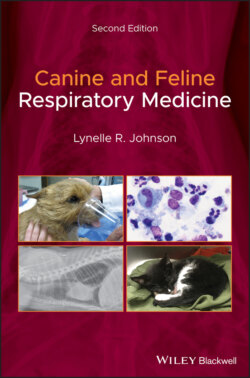Читать книгу Canine and Feline Respiratory Medicine - Lynelle Johnson R., Lynelle R. Johnson - Страница 16
Loud Breathing Definition
ОглавлениеLoud breathing most commonly results from a disorder affecting the nasal cavity or upper airway (larynx, pharynx, or cervical trachea), although occasionally animals with lower airway disease will present for loud, audible breathing. Stertor and stridor are loud sounds resulting from narrowing of upper or large airways typically, and are often audible without a stethoscope, although subtle stridor can be missed without specific auscultation over the larynx. Importantly, some animals will suffer from both stertor and stridor, which can have important ramifications for documenting the extent and severity of the obstructive disease, as well as defining optimal treatment.
Stertor is a discontinuous gurgling or snoring sound that is produced as air flows past a soft tissue obstruction in the upper airway. It can be caused by narrowing within the nasal cavity, by elongation or thickening of the soft palate, or by edema or eversion of laryngeal saccules. Tonsillar enlargement or mass lesions in the oral cavity can also lead to stertor. In brachycephalic dogs and cats, it is not possible to localize the source of stertor on physical examination alone and stertor is often multi‐factorial. Stertor varies in tone and pitch, and it can be audible on inspiration, expiration, or both.
In contrast, stridor is classically an inspiratory noise of a single, high pitch that results from rapid flow of air past a rigid obstruction, such as a paralyzed or collapsed larynx. Stridor can also be heard in an animal with a laryngeal mass or occasionally in an animal with nasopharyngeal stenosis. It can also be ausculted in an animal with a fixed large airway obstruction due to stenosis, hypoplasia, compression, or a mass effect. The airway obstruction can be anywhere from the larynx to the cervical or intrathoracic trachea. In severe cases where a large mass is obstructing airflow, stridor can be present on both inspiration and expiration. Finally, cervical tracheal collapse can also result in stridor typically on inspiration.
Epiglottic retroversion is a cause of intermittent airway obstruction in dogs in which respiratory distress is present in conjunction with stridor or stertor. Although rarely reported, it is increasingly recognized as a cause of serious clinical disease (see Chapter 5).
